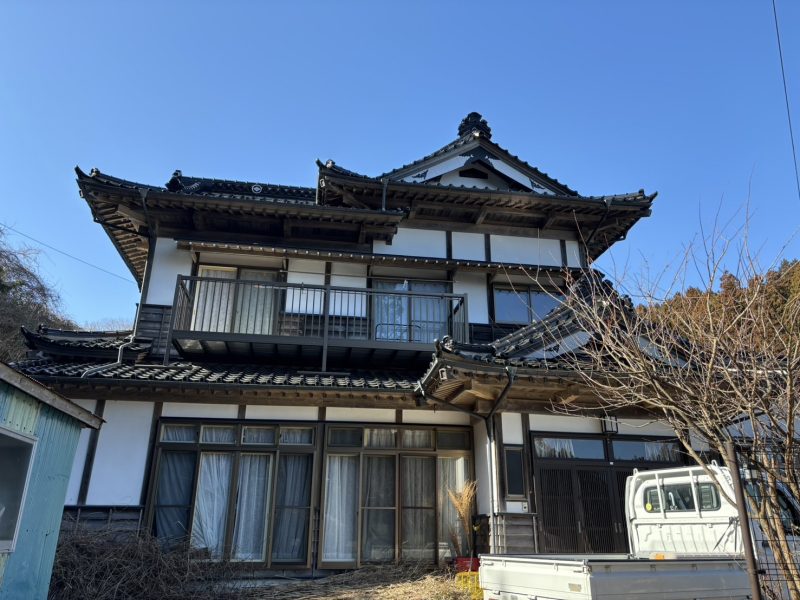
 Verify availability
Verify availabilityAdd to lists:✕

This 8DK property is located in Hirota-cho, a port town with the smell of the sea. It is a 24-minute drive from the city center. There is a fishing port near the house, so you can enjoy walking along the coast and fishing.海の匂いが漂う港町、広田町にある8DKの物件。市街地から車で24分で到着します。家の近くには、漁港があり海岸の散歩や釣りを楽しむことができます。
| Land:土地面積 | 955 m² |
|---|---|
| Building:建物面積 | 204 m² |
| Scale:建物規模 | 2 stories2階建て |
| Structure:構造 | Two-story wooden building with tiled roof木造瓦葺2階建て |
| Built in:建築年 | 2000 |

Rental only is not permitted. This property is available for sale.賃貸のみは不可。売買が条件の賃貸物件です。
| Security deposit:敷金 | 20,000 yen2万円 |
|---|---|
| Key money:礼金 | 3 million yen300万円 |
| Land:土地面積 | 140 m² |
| Building:建物面積 | 132 m² |
| Structure:構造 | Wooden one-story house木造平家 |
| Built in:建築年 | 1985 |

It is a property for sale and rental in the Fukagawa Yumoto area. In 2016, the "Nagato Yumoto Onsen Tourism Town Development Plan" was formulated with the aim of revitalizing Nagato Yumoto Onsen, and town development for the future has been promoted while inheriting the good old traditions. Please enjoy the reborn Yumoto hot spring town for a "walk". There is a concrete barbecue table in the large garden, and it used to be a place for family gatherings. The vacant house has been vacant for a long time, but it is regularly managed.深川湯本エリアの売買・賃貸物件です。2016年に長門湯本温泉の再生を目的とした「長門湯本温泉観光まちづくり計画」が策定され、古き良き伝統を受け継ぎつつ、未来に向けてのまちづくりが進められてきました。生まれ変わった湯本温泉街で『そぞろ歩き』をお楽しみください。広い庭にはコンクリート製のバーベキュー台があり、昔はご家族の団欒の場として活躍していたそうです。空き家の期間が長いですが、定期的に管理はされています。
| Security deposit:敷金 | Security deposit 50,000 yen敷金5万円 |
|---|---|
| Key money:礼金 | Key money: 50,000 yen礼金5万円 |
| Land:土地面積 | 383 m² |
| Building:建物面積 | 128 m² |
| Structure:構造 | Two-story wooden building with tiled roof木造瓦葺2階建 |
| Built in:建築年 | 1981 |

It is along the prefectural road and has good access. Properties in a quiet environment.県道沿いであり、アクセスは良好。静穏な環境の物件。
| Security deposit:敷金 | Deposit敷金 |
|---|---|
| Key money:礼金 | Key money礼金 |
| Land:土地面積 | 470 m² |
| Building:建物面積 | 111 m² |
| Structure:構造 | Building 111.38m2, Land 470.85m2 (142.43 pyeong)建物111.38m2、土地470.85m2(142.43坪) |
| Built in:建築年 | 1978 |

Contract type: Rental
Address: Kawahigashi, Shirakawa-cho
Structure: 2-story wooden building
Year built: 1982
Area: 582.5 Residential land area / 197 floors
Parking space: Available
Toilet: Flush toilet
Other: *Japanese-style toilet
*One 8-tatami Japanese-style room cannot be used契約形態:賃貸
住所:白川町河東
構造:木造2階建て
築年:1982年
面積:宅地582.5 / 床197
駐車スペース:有り
トイレ:水洗
その他:※和式便器
※和室8畳1室使用不可
| Land:土地面積 | 582 m² |
|---|---|
| Building:建物面積 | 197 m² |
| Structure:構造 | Two-story wooden building木造2階建て |
| Built in:建築年 | 1982 |

It is a wooden house with four Japanese-style rooms arranged in a square shape on the first floor and three Western-style rooms on the second floor. It is also available for rent (25,000 yen per month). The property is 592 sq. meters, so you can enjoy gardening and vegetable growing.1階に田の字形の和室4室、2階に洋室3室の木造住宅。賃貸(月2万5000円)利用もできる。敷地は150坪あるので、庭いじりや家庭菜園を楽しんでみたい。
| Security deposit:敷金 | Noneなし |
|---|---|
| Key money:礼金 | Noneなし |
| Land:土地面積 | 498 m² |
| Building:建物面積 | 87 m² |
| Scale:建物規模 | 2 stories2階建て |
| Structure:構造 | Wooden木造 |
| Built in:建築年 | 1950 |

Japan is an enticing destination for those looking to immigrate and start a new life. It is a country that seamlessly blends rich tradition with cutting-edge modernity. One of the key factors that make Japan so attractive to prospective immigrants is the housing availability. While Japan's bustling metropolises like Tokyo, Osaka, and Kyoto offer a wide range of housing options, from modern apartments to traditional machiya, the country also faces a unique issue: a surplus of vacant houses, especially in rural areas. This provides an intriguing opportunity for immigrants to potentially acquire properties at reasonable prices, often at a fraction of what one might pay in major cities.
Japan's real estate market is diverse and can cater to various budgets. While cities like Tokyo tend to be on the higher end of the spectrum, there are still affordable options to be found in the suburbs and smaller towns. This inclusivity in housing costs allows immigrants to select a location that suits their financial circumstances.
AllAkiyas.com puts at your disposition thousands of Japanese real estate listings of properties available for sale or rent. Our extensive listings include detached houses, townhouses, apartments, commercial spaces, and vacant lots. We place a special focus on traditional vacant houses, known as akiya (or kominka in rural areas), and traditional townhouses, or machiya. You can easily search for properties across all of Japan's prefectures using your specific criteria.